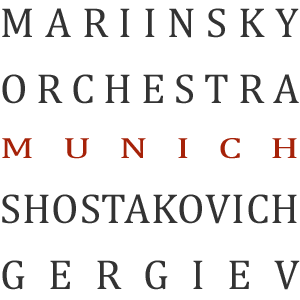Gergiev's Munich Shostakovich - Symphonies 7 & 9
If you are looking for hoppity-hop in Shostakovich, the Sixth Symphony is good. The Ninth is better. If you are looking for Wham! Bang! Pow!, the Tenth is good. The Seventh is better. In a way the Sunday concert of Munich’s bi-orchestral Gergiev-Shostakovich cycle was the enhanced parallel of Saturday’s concert. It showed in the attendance, too. Two of the nosebleed segments were still blocked out, but the rest of the Philharmonic Hall was solidly filled: A vote of wallet for the popularity of these two symphonies.
At a symposium earlier that day, Gergiev grumbled that to ignore the humor in DSCH was to miss the point of his music entirely. That’s particularly true for the Ninth Symphony, coy and glittery and frivolously charming, with a brass section that sounds like the Keystone Kops at band-camp. Dainty ballet-girls and beer hall oompah-bands never existed in such harmonious proximity. Deliberately undercutting the mythical status that Beethoven set for a “Ninth Symphony” already made a (musical) statement in and of itself. Doing so in the summer of 1945, following the defeat of Nazi Germany and after announcements in the press had suggested a “Victory Symphony”, added another, political, dimension. Imagine collective expectations of a high-holy paean to Stalin, vanquisher of evil and preserver of the people. And then you get the symphonic equivalent of “Ding Dong the Witch is Dead.” In a place and at a time where being apolitical (never mind wrong-political) was a crime, that was strong stuff.
 D.Schostakovich, Sy. 7, L.Bernstein / Chicago SO DG      D.Schostakovich, Sy. 9 (+ 'faked' Mravinsky 5th), Z.Kosler/ Czech PO Chant du Monde     |
The Seventh Symphony has many great stories attached to it, starting with the fact that, although composed and premiered in Kuybyshev (todays Samara), it was performed in Leningrad when the city was still surrounded by the Wehrmacht. Russian artillery halted as loudspeakers blared it across the fields, live, to the besieging Germans. (The exact effect it had is not known.) A year prior, Shostakovich had posed for rather adorable propaganda photos as a volunteer Home Guard in the firefighting brigade, ready to protect the Leningrad Conservatory from incendiaries—a version of which famously ended up on the cover of Time Magazine (July 20, 1942). Then there’s the bit how the score was flown—on microfilm and via Teheran—to the US. There Arturo Toscanini, Leopold Stokowski, and Serge Koussevitzky started duking it out over who would get to perform the American premiere. Toscanini won in that he got to perform the radio broadcast and North American premiere on July 19th, 1942. (When Shostakovich later heard the record of performance, he was apparently aghast.) Koussevitzky meanwhile, the Russian of the lot, won the consolation prize and got to conduct the first concert performance one month later.) The work, a popular and enjoyably crude humdinger of a symphony, made Shostakovich an instant international cultural icon in the free world.
Well-meaning (or self-serving) commentators have attempted to turn this symphony from an anti-Nazi symphony (a popular cause in the 40s) into an anti-Totalitarian symphony (more popular in the West during the Cold War). Believe that, if you will… the extra musical elements—“War – Memories – Home – Victory”—are plausible either way. In 2012 the flavor of the political interpretation isn’t likely to determine symphony’s popularity, anyway. The Bolero-like increase of tension in the first movement is more likely the clincher. Under Gergiev it contrasted nicely with delicate pizzicati so soft that they had to be seen to be heard. Total comfort with the idiom meant that the Mariinsky Orchestra was able to perform with seasoned routine in the very best sense. At 80 minutes, the Symphony is arguably too long for its own good, but just before it slipped from the audience’s attention-grip, Gergiev gave a little kick to the proceedings and with several audible grunts he ushered the Allegro to its eventual finale.
It’s easy to pooh-pooh Gergiev and the flaws amid his PR-blitzes, overburdened schedules, and casual rehearsal attitude. It’s a healthy corrective then, to hear how good he is at his best. With the Mariinsky, in Shostakovich, in these concerts, he was, and it was very good, indeed.
























































No comments:
Post a Comment